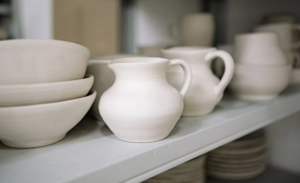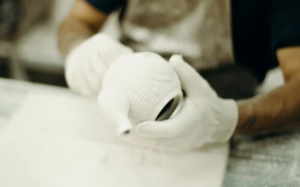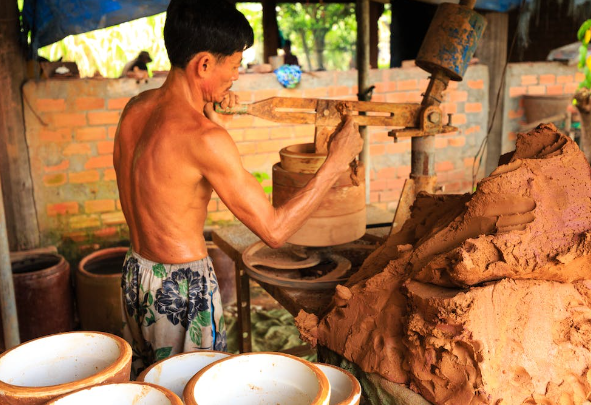Table Of Contents
- 1 Unveiling the Art of Pinch Pot Clay Sculpting: A Beginner’s Guide
- 1.1 What is Pinch Pot Clay Sculpting?
- 1.2 Benefits of Pinch Pot Clay Sculpting:
- 1.3 Essential Tools and Materials:
- 1.4 Mastering the Fundamentals of Pinch Pot Clay Sculpting
- 1.5 2. Forming the Pinch Pot Base:
- 1.6 3. Shaping and Refining:
- 1.7 4. Building Walls and Adding Height:
- 1.8 5. Adding Handles and Attachments:
- 1.9 6. Creating Openings and Holes:
- 1.10 7. Finishing Touches and Decoration:
- 1.11 Elevate Your Pinch Pot Clay Sculpting Skills: Advanced Techniques and Tips
- 1.12 1. Adding Unique Textures and Surface Variations:
- 1.13 2. Shaping and Detailing with Precision:
- 1.14 3. Assembling Complex Forms and Structures:
- 1.15 4. Enhancing Functionality and Versatility:
- 1.16 5. Expressive Decoration and Personalization:
- 1.17 6. Pushing the Limits of Pinch Pot Sculpting:
- 1.18 Sharing Your Pinch Pot Clay Sculptures and Beyond
- 1.19 1. Sharing Your Creations:
- 1.20 2. Preserving Your Creations:
- 1.21 3. Expanding Your Artistic Journey:
Unveiling the Art of Pinch Pot Clay Sculpting: A Beginner’s Guide
Embrace the simplicity and endless possibilities of pinch pot clay sculpting! This fundamental technique, accessible to all experience levels, allows you to transform a simple ball of clay into charming figurines, decorative objects, and expressive sculptures. In this first session, we’ll explore the basics of pinch pot sculpting, making it fun and approachable for everyone.
What is Pinch Pot Clay Sculpting?
Pinch pot sculpting involves pinching and manipulating a ball of clay to create hollow forms. This technique is perfect for beginners, as it requires minimal tools and relies primarily on your hands. The basic concept is incredibly simple, yet the possibilities for creativity are endless.
Benefits of Pinch Pot Clay Sculpting:
- Simplicity: Easy to learn and master, requiring no prior experience or specialized equipment.
- Accessibility: Affordable materials and minimal workspace needed, making it a budget-friendly craft.
- Versatility: Create a diverse range of sculptures, from simple bowls and animals to intricate figurines and abstract forms.
- Therapeutic: The repetitive motion of pinching and shaping clay can be calming and stress-relieving.
- Expressive: A fantastic way to explore your creativity and personal style through art.
Essential Tools and Materials:
- Clay: Choose a type of clay suitable for pinch pots, such as air-dry clay, polymer clay, or stoneware.
- Water: Used for keeping your hands and tools moist, and for smoothing the clay.
- Sponges: Use damp sponges to smooth out surfaces and remove excess clay.
- Toothpicks or sculpting tools: Helpful for adding details and textures.
- Rolling pin (optional): For flattening clay sheets to create specific shapes.
Prepare to delve deeper into the world of pinch pot clay sculpting in the next session. We’ll explore fundamental techniques in detail, equipping you with the knowledge and skills to create your first pinch pot masterpiece!

Mastering the Fundamentals of Pinch Pot Clay Sculpting
Welcome back, aspiring pinch pot artists! In this session, we’ll delve deeper into the core techniques that will empower you to bring your clay creations to life.
1. Preparing the Clay:
- Wedging: This process removes air bubbles and ensures an even consistency for smoother sculpting.
- Kneading: Makes the clay soft and pliable, allowing you to manipulate it easily.
2. Forming the Pinch Pot Base:
- Roll a ball of clay in your palms to create a smooth, even sphere.
- Use your thumb and index finger to gently pinch the top of the sphere, creating a small opening.
- Continue pinching and thinning the walls, working your way down from the top.
- Maintain a consistent thickness for stability and avoid creating holes.
3. Shaping and Refining:
- Use your fingers and thumbs to shape the clay into your desired form.
- Pinch, press, and curve the clay to create different shapes and features.
- Use toothpicks or sculpting tools to add details like eyes, mouths, or patterns.
- Smooth out any imperfections with a damp sponge.
4. Building Walls and Adding Height:
- To create taller forms, continue adding clay by pinching and attaching coils around the existing base.
- Ensure secure attachment by scoring the surfaces and using slip (clay and water mixture) for better adhesion.
- Gradually build the walls, maintaining consistent thickness and smooth transitions.
5. Adding Handles and Attachments:
- Pinch small pieces of clay into desired shapes for handles, ears, horns, or other features.
- Score the attachment area on the main body and the base of the added piece.
- Apply slip and gently press the pieces together, ensuring good contact.
- Smooth out the joins seamlessly and refine the details.
6. Creating Openings and Holes:
- To create hollow forms, continue pinching the clay until the desired thickness is reached.
- Leave a small opening at the top or bottom for air circulation during drying.
- Alternatively, create holes for decorative purposes using toothpicks or sculpting tools.
7. Finishing Touches and Decoration:
- Once satisfied with the shape and details, use a damp sponge to smooth out any remaining imperfections.
- Add textures and patterns using tools, stamps, or natural objects.
- Decorate your creation with paint, glaze, or other embellishments once dry.
Congratulations! You’ve now mastered the fundamental techniques of pinch pot clay sculpting. With practice and creativity, you can create a vast array of beautiful and expressive pinch pot sculptures. In the next session, we’ll explore advanced techniques and tips to take your sculpting skills to the next level!

Elevate Your Pinch Pot Clay Sculpting Skills: Advanced Techniques and Tips
Embrace the challenge and elevate your pinch pot clay sculpting skills to new heights! In this session, we’ll explore advanced techniques, tips, and tricks to transform your creations into masterpieces.
1. Adding Unique Textures and Surface Variations:
- Texture Mats: Use texture mats to imprint various textures onto your clay, adding depth, dimension, and visual interest to your sculptures.
- Imprinting Objects: Use natural objects like leaves, shells, or stamps to create unique textures and patterns on your clay.
- Layering Clay Colors: Combine different clay colors to create a variety of textures, such as marbling or faux fur.
2. Shaping and Detailing with Precision:
- Fine-tipped Sculpting Tools: Use fine-tipped sculpting tools, such as needle tools or ball styluses, to add delicate details, refine features, and create intricate patterns.
- Creating Holes: Use a needle tool to create holes for adding decorative elements, such as beads or pendants.
- Embossing and Carving: Employ carving tools to sculpt realistic details, create depth, and add texture to your creations.
3. Assembling Complex Forms and Structures:
- Joining Coils: Join coils together to create thicker sections or curved forms without compromising strength.
- Layering Coils: Alternate coil widths and thicknesses to create variations in texture and visual interest.
- Combining Techniques: Utilize a combination of pinch building, shaping, and carving techniques to create intricate and detailed sculptures.
4. Enhancing Functionality and Versatility:
- Creating Smooth Surfaces: Use a damp sponge to smooth out any imperfections and achieve a polished finish.
- Adding Functional Elements: Attach handles, feet, or lids to create functional objects like bowls, cups, or vases.
- Experimenting with Different Clay Types: Explore various clay types, such as air-dry clay, polymer clay, or stoneware, to suit your project’s needs and desired characteristics.
5. Expressive Decoration and Personalization:
- Painting and Glazing: Enhance your pinch pot sculptures with vibrant colors and glazes to achieve a unique aesthetic.
- Embellishments and Adornments: Add beads, charms, or other decorative elements to personalize your creations.
- Incorporate Found Objects: Integrate found objects like buttons, twigs, or shells for textural contrast and a touch of rustic charm.
6. Pushing the Limits of Pinch Pot Sculpting:
- Creating Assemblages: Combine multiple pinch pot pieces to create cohesive and visually striking compositions.
- Incorporating Mixed Media Techniques: Explore the fusion of pinch pot sculpting with other art forms, such as painting, drawing, or textiles, to create unique and eye-catching pieces.
- Experimenting with Abstract Forms: Challenge yourself to create abstract sculptures that transcend traditional forms and evoke emotions or concepts.
Remember, pinch pot clay sculpting is a journey of continuous learning and experimentation. Embrace the process, have fun, and let your creativity flourish!
Sharing Your Pinch Pot Clay Sculptures and Beyond
Congratulations! You’ve embarked on a rewarding journey of pinch pot clay sculpting, mastering techniques and creating unique pieces. In this final session, we’ll explore ways to share your passion, preserve your creations, and continue your artistic journey.
1. Sharing Your Creations:
- Exhibitions and Events: Participate in local art shows, craft fairs, or online galleries to showcase your work and connect with other artists and enthusiasts.
- Social Media: Share your creations and progress on social media platforms like Instagram, YouTube, or TikTok to inspire others and build a community.
- Teaching and Workshops: Pass on your knowledge and passion by offering workshops or classes to teach others the art of pinch pot clay sculpting.
2. Preserving Your Creations:
- Glazing and Firing: Glazing and firing your creations in a kiln creates a durable finish and enhances their beauty.
- Sealing and Protecting: Apply a sealant to protect your sculptures from dust, moisture, and fading.
- Documentation and Storage: Take high-quality photos and videos of your work for your records and to share online. Store your creations safely in a dry and dust-free environment.
3. Expanding Your Artistic Journey:
- Explore Different Clay Types: Experiment with various types of clay, such as porcelain, stoneware, or raku, each offering unique properties and challenges.
- Learn New Techniques: Challenge yourself by learning advanced techniques like surface decoration, mold making, or slip casting.
- Combine Clay with Other Art Forms: Explore mixed media art by integrating clay pinch building with techniques like painting, drawing, or fiber arts.
- Seek Inspiration and Resources: Immerse yourself in the world of ceramics by visiting exhibitions, museums, and online resources to discover new approaches and broaden your artistic horizons.
Remember, the journey of clay pinch building is a continuous cycle of learning, creating, and sharing. Embrace every step of the process, nurture your passion, and let your artistic journey unfold beautifully.

1 thought on “Unveiling The Art Of Pinch Pot Clay Sculpting A Beginner’s Guide”